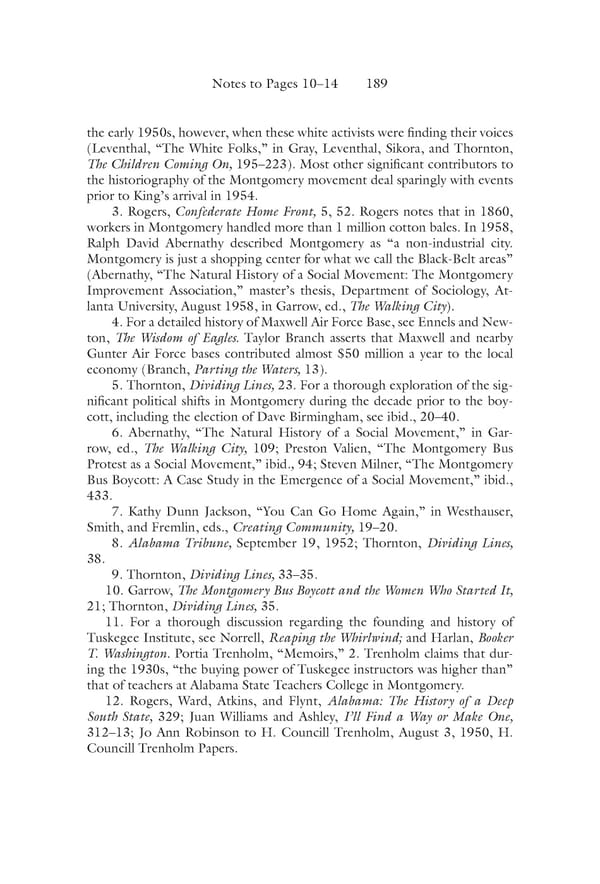Notes to Pages 10–14 189 the early 1950s, however, when these white activists were finding their voices (Leventhal, “The White Folks,” in Gray, Leventhal, Sikora, and Thornton, The Children Coming On, 195–223). Most other significant contributors to the historiography of the Montgomery movement deal sparingly with events prior to King’s arrival in 1954. 3. Rogers, Confederate Home Front, 5, 52. Rogers notes that in 1860, workers in Montgomery handled more than 1 million cotton bales. In 1958, Ralph David Abernathy described Montgomery as “a non-industrial city. Montgomery is just a shopping center for what we call the Black-Belt areas” (Abernathy, “The Natural History of a Social Movement: The Montgomery Improvement Association,” master’s thesis, Department of Sociology, At- lanta University, August 1958, in Garrow, ed., The Walking City). 4. For a detailed history of Maxwell Air Force Base, see Ennels and New- ton, The Wisdom of Eagles. Taylor Branch asserts that Maxwell and nearby Gunter Air Force bases contributed almost $50 million a year to the local economy (Branch, Parting the Waters, 13). 5. Thornton, Dividing Lines, 23. For a thorough exploration of the sig- nificant political shifts in Montgomery during the decade prior to the boy- cott, including the election of Dave Birmingham, see ibid., 20–40. 6. Abernathy, “The Natural History of a Social Movement,” in Gar- row, ed., The Walking City, 109; Preston Valien, “The Montgomery Bus Protest as a Social Movement,” ibid., 94; Steven Milner, “The Montgomery Bus Boycott: A Case Study in the Emergence of a Social Movement,” ibid., 433. 7. Kathy Dunn Jackson, “You Can Go Home Again,” in Westhauser, Smith, and Fremlin, eds., Creating Community, 19–20. 8. Alabama Tribune, September 19, 1952; Thornton, Dividing Lines, 38. 9. Thornton, Dividing Lines, 33–35. 10. Garrow, The Montgomery Bus Boycott and the Women Who Started It, 21; Thornton, Dividing Lines, 35. 11. For a thorough discussion regarding the founding and history of Tuskegee Institute, see Norrell, Reaping the Whirlwind; and Harlan, Booker T. Washington. Portia Trenholm, “Memoirs,” 2. Trenholm claims that dur- ing the 1930s, “the buying power of Tuskegee instructors was higher than” that of teachers at Alabama State Teachers College in Montgomery. 12. Rogers, Ward, Atkins, and Flynt, Alabama: The History of a Deep South State, 329; Juan Williams and Ashley, I’ll Find a Way or Make One, 312–13; Jo Ann Robinson to H. Councill Trenholm, August 3, 1950, H. Councill Trenholm Papers.
 Becoming King: Martin Luther King Jr. Page 209 Page 211
Becoming King: Martin Luther King Jr. Page 209 Page 211